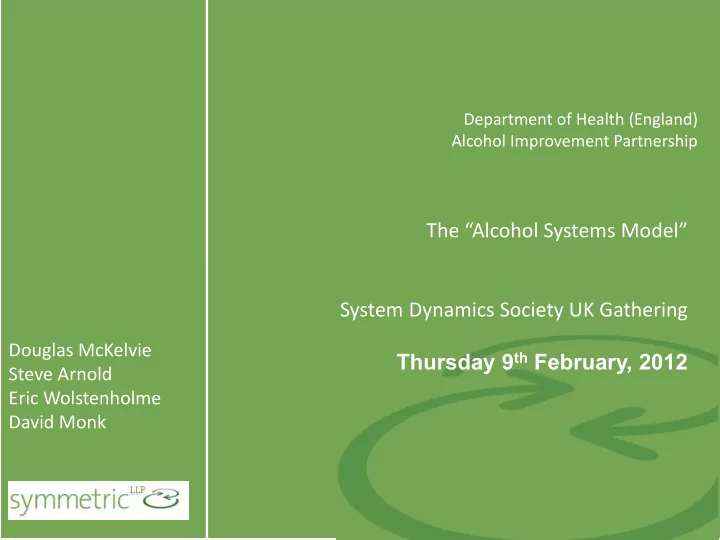

Department of Health (England) Alcohol Improvement Partnership The “Alcohol Systems Model” System Dynamics Society UK Gathering Douglas McKelvie Thursday 9 th February, 2012 Steve Arnold Eric Wolstenholme David Monk
This is the population of England…….
DRINKING AT LOWER RISK ABSTAINERS DRINKING AT INCREASING RISK 24.8m 5.8m 7.6m 7.6m “men who drink more than 3 to 4 units a day (2 glasses of wine) run an increasingly Common view of “alcohol problems” significant risk of illness and death from a This is the population • Binge drinking Binge Drinking number of conditions, including • Dependence/alcoholism of England……. 7.7m 7.7m haemorrhagic stroke, some cancers, This project • Broader health problems associated accidents and hypertension” with alcohol CONSUMPTION • “Increasing Risk” ( > 2 glasses of wine per day for men, 1.5 for women) Dependent Drinking • “Higher Risk” (> 3.5 or 2.5 glasses) 1.1m UK General Lifestyle Survey HIGHER RISK DRINKING 2.9m Sources: General Household Survey 2006 and mid-2006 population estimates (ONS). dependent drinking fig - ANARP 2005 (DH)
Department of Health “Ready Reckoner” (Spreadsheet) user input Hillingdon Admissions Select PCT in drop down box below The Good News: to tackle CONSUMPTION, as opposed to PCT Increasing Risk Drinkers 44,751 Symmetric Project Brief: 7000 Hillingdon 5AT Higher Risk Drinkers 10,886 Dependent 5,867 Binge 21,593 BINGE DRINKING or DEPENDENT DRINKING, relatively 6000 • To develop a “tool” similar to Alcohol Health Workers (AHW) inexpensive treatments (brief advice, brief interventions), N on-dependent drinkers 5000 Visits/admissions averted some of which can be implemented in primary care, can N umber of nurses wte A&E hospital 4000 extra cost benefit Ready Reckoner but more of a 2009/10 10.00 5,500 367 £600,000 £675,000 be effective. 2010/11 10.00 5,500 367 £600,000 £675,000 3000 2011/12 10.00 5,500 367 £600,000 £675,000 Alcohol Health Workers (AHW) “model” with a User Friendly 2000 Dependent drinkers visits/admissions averted N umber of nurses wte A&E hospital extra cost benefit As a way of demonstrating why it is worthwhile to spend 2009/10 1.00 295 172 £60,000 £145,200 ## 1000 2010/11 1.00 295 172 £60,000 £145,200 Interface 2011/12 1.00 295 172 £60,000 £145,200 money on these interventions, the Department of Health 0 Treatment-dependent drinkers N umber 5,867 developed a spreadsheet to be used by local MET or SBNT counselling packages (UKATT) • Assumption that the Ready Increase in treatment: percentage points of prevalence (ppop), or input extra proposed to treat A&E extra %popextra treated hospital extra cost benefit commissioners. 2009/10 2.0 100 18 22 £20,000 £61,100 - Past trend 2010/11 2.0 117 21 26 £23,500 £71,700 - Projection 2011/12 2.0 117 21 26 £23,500 £71,700 - Future trend with the selected interventions Reckoner was probably “correct” IBA - GP screening new registrants input number screened % screened who get BA 20% 16,979 A&E screened hospital extra cost benefit 2009/10 5000 1.0 20 18 £15,500 £14,600 2010/11 5000 1.0 32 20 £15,500 £16,600 2011/12 5000 1.0 45 21 £15,500 £18,700
£ Policies increasing increasing increasing Lower Higher Increasing Abstainers Risk Risk Risk reducing reducing reducing
£ Policies increasing increasing increasing Higher Lower Increasing Abstainers Risk Risk Risk reducing reducing reducing Services Services £ Services
£ Hospital Admissions increasing increasing increasing Higher Lower Increasing Abstainers Risk Risk Risk reducing reducing reducing £ Services
Policies - increasing risk time Consumption Hospital £ lag Admissions + reducing risk Services Services Services
Time Period Covered – 20years 2005 2010 2020 • New services are introduced in 2010 • Further changes can be made when the model pauses • Note the time delay before some effects register
What is the Underlying Flow Rate between Consumption Groups? • It cannot be deduced from observing the stocks This simple insight led to the = Department of Health calculating, for the first time, what the underlying rate of movement between = consumption groups actually is.
The model works by enabling a user to • Introduce a new service capacity, at a point in time • Make assumptions about its impact on alcohol consumption (screen not shown) Then on the model dashboard, user can switch on these new service settings, and observe the impact on hospital admissions and total costs
Total admissions Total costs Change in admissions (pa) Change in total costs (pa)
Impact of Brief Advice Services on Whole Population over Time
• Model simulates some key dynamics that are harder to show on a spreadsheet • time delay between intervention and health improvement • Cumulative impact on Population • Dynamic view of changing consumption, new data • “Invest to save”, the case is made, but there will be a few years of higher expenditure at a time when costs are tight • Available as a “runtime” tool for commissioners in England (and anyone else interested) • Wider public benefits of reductions in alcohol consumption can also be considered (some interest in the model from the criminal justice system) • There may be less costly ways of reducing alcohol consumption, e.g. “minimum pricing”
For further information:- douglas.mckelvie@symmetricpartnership.co.uk Model available at:- http://www.alcohollearningcentre.org.uk/Topics/Browse/Data/Datatools (or search for “alcohol systems model” “Department of Health” “Alcohol Learning Centre” “England”)
Recommend
More recommend